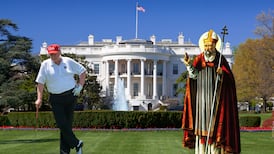In October 2013, just months after that year’s fodder crisis, a study by researcher Dr Stephen Flood warned of severe future impacts of climate change on Irish agriculture. Then agriculture minister Simon Coveney launched the report, and promised that climate projections would be incorporated into plans for the sector.
A starker appraisal of the scientific evidence was delivered by then IFA president John Bryan, who dismissed the report as being “based on unsubstantiated assumptions”. As far as he was concerned “what is real and deliverable are the growth plans for the sector”. And to hell with the science. The IFA, not Coveney’s, view prevailed.
So, as climate-fuelled extreme weather events – hurricanes to major flooding episodes and unseasonal cold snaps – batter Ireland with monotonous regularity, hitting the agriculture sector hardest, the de facto position of Ireland’s major farmer representative group appears one of outright denial of the dangerous reality of climate change.
This gross negligence is putting ordinary farmers and their families in jeopardy.
The 2012/13 fodder crisis was a warning shot that Ireland may not be able to produce enough fodder for its then almost seven million cattle.
Yet instead of looking long and hard at the sustainability of the beef and dairy sector, the industry doubled down by increasing the dairy herd by over 300,000 cows since milk quotas were lifted in 2015. This reckless gamble was celebrated as though it were a stroke of genius.
Emissions fines
Ireland’s EU agriculture commissioner Phil Hogan recently warned of “unsustainable increases” in milk production, adding that Irish agriculture was “sleepwalking” towards massive EU emissions fines. There was, he concluded, a “gulf between rhetoric and reality”.
He was only talking about economics. Hogan could have added that today’s 7.3 million beef and dairy cattle are placing almost intolerable strain on Ireland’s biodiversity, water safety and air quality, while contributing massively towards the very climate change that is now battering the sector.
The Environment Protection Agency’s 2016 report found that Ireland’s levels of ammonia and nitrogen-oxides were now, for the first time, in breach of EU emissions levels. Some 99 per cent of ammonia emissions arise from fertilisers and animal manures. The EPA added that this would “cause damage to air quality and health”.
The IFA successfully lobbied last year for a further derogation from the EU Nitrates Directive, a measure to protect water quality and public health. This derogation allows Irish farmers to carry higher stocking rates of animals than allowed elsewhere in Europe, and so has played no small part in exacerbating the current fodder crisis.
It was celebrated as a victory for Ireland by ministers Michael Creed and Eoghan Murphy. In contrast, the Dutch government ordered its farmers to reduce stock levels to comply with the directive.
Growth targets
The current industry-driven Food Harvest 2025 policy sets aggressive growth targets for the sector. Government funding for Bord Bia has shot up by 56 per cent in the last eight years, and it now has a hefty €70 million annual PR and promotional budget with which to promote misty-eyed spin like “Origin Green”.
In the same period funding for protection of Ireland’s actual natural heritage via the National Parks and Wildlife Service has been slashed. Nature has been reduced to a hollow marketing slogan.
Our beef and dairy system was found to produce the most carbon emissions per euro of food output in the entire EU
Bord Bia boasts that tens of thousands of farmers are signed up to its National Food Sustainability Programme. When I asked how many applications had been refused, the figure given was 0.5 per cent. This paints the fantastical picture that 99.5 per cent of Ireland’s farmers are practising sustainable, ecologically-friendly agriculture.
When assessing how truly “green” a farming system is, the obvious place to start is to see how widespread is organic farming. Ireland has the least amount of farm land in the EU engaged in organic agriculture at just 1.6 per cent.
Ireland also has the second lowest area of land producing vegetables in the EU.
Depressingly, our much vaunted beef and dairy system was found in an EU Parliament study published last April to produce the most carbon emissions per euro of food output in the entire EU28. Further, UN data shows that Ireland is in fact a net importer of food calories, importing the calorie equivalent of food for 1.4 million people.
As the ships docked in Rosslare unloading imported fodder have shown once again, our current agricultural model is failing most farmers, the environment and wider society.
Beef levy
A little known interest on the part of the IFA is that between a third and a half of its income comes via the so-called beef levy, which is deducted by beef factories from farmers’ cheques and sent straight to the IFA.
The association would struggle without this income, yet the increasingly tenuous official line is that this huge cash cow doesn’t make it beholden to the beef barons or hog-tied to promoting outdated agricultural models to preserve its own income.
Maybe now is the time to divert the “beef levy” away from covering the huge salary bill at Farm Centre and into a special fund to help bail out farmers as future weather emergencies hammer the sector?
John Gibbons is an environmental writer and commentator














